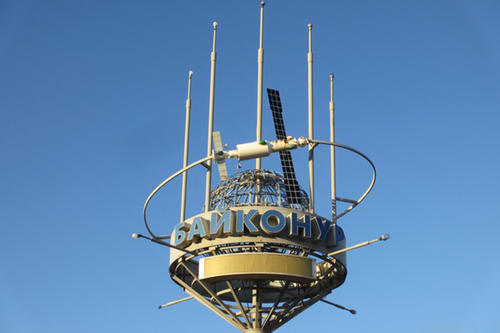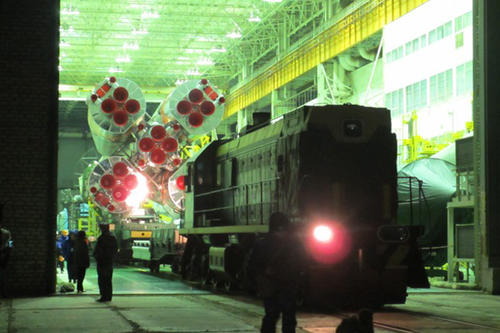Giant Steps for Humankind
A researcher from Freie Universität is using sociological methods to study space travel.
May 22, 2017
Paola Castaño studies the sociology of space travel.
Image Credit: Privat
Paola Castaño is interested in the scientific studies performed in the rocket’s “space lab.”
Image Credit: Privat
It’s a long way to launch: Paola Castaño had to fly through Moscow and the Kazakh capital of Astana first, then to Kyzylorda, and from there she traveled by bus to Baikonur, some 300 kilometers away.
Image Credit: Privat
The rocket is traditionally transported from the hangar to the launch site by diesel locomotive and dedicated by Orthodox priests before launching.
Image Credit: Privat
It is just after two a.m. in Baikonur, Kazakhstan, and so bitterly cold that Paola Castaño huddles deeper into her coat. She has been standing here for hours, at minus 18 degrees Celsius, just a kilometer away from the launch pad for the Soyuz rocket. She is waiting for the moment of truth, when everyone will find out whether the calculations were correct, whether the materials will hold, whether everything will go as planned.
The rocket carries three astronauts – Oleg Novitskiy, Peggy Whitson, and Thomas Pesquet – strapped into a cramped space. Then comes a light, as if the sun were suddenly rising. The Earth shakes under Castaño’s feet, and within just a few seconds, the space capsule becomes a star, receding into the night sky before disappearing.
Castaño was able to observe the launch of the manned Soyuz MS-03 spaceflight on November 18, 2016. It was, as she says, “probably a once-in-a-lifetime experience, and truly a stroke of luck.” After all, Castaño, who is originally from Colombia, is not an engineer or rocket technician, nor is she a family member of any of the astronauts. Instead, she studied history and political science and earned a doctorate in sociology.
Her unusual field of research: the sociology of space travel. As part of her work as a researcher at the Smithsonian National Air and Space Museum, in Washington, and Freie Universität Berlin, Castaño has made a career of studying space exploration. She is currently employed at the John F. Kennedy Institute for North American Studies at Freie Universität, where she is working on a book about research on the International Space Station (ISS).
“It was important for my work to see a rocket launch with my own eyes. It’s not enough to just read about it,” Castaño says, explaining why she traveled to Baikonur. “I was extremely lucky that my request was approved and I could be there in the end, although the launch was postponed several times.”
She flew through Moscow and the Kazakh capital of Astana first, then on to Kyzylorda, and from there she traveled by bus to Baikonur, some 300 kilometers away. “I spent five days here and had the opportunity to observe the complex logistics and the rocket’s preparations. As an outsider, you have no idea what kinds of highly complex processes are involved.” Castaño was also able to speak with interested parties on site, asking them about their work and motivations – interviews she hopes to use in her book about space travel.
“I am studying the ISS as a transnational institution. According to my research, there are very few institutions that are so emblematic of successful international cooperation,” Castaño explains. “This is unique,” she adds. Castaño is specifically interested in the scientific experiments performed in the “space lab.”
“I am studying experiments from the fields of biological sciences and medicine, botany and particle physics, for example. I ask about various things, such as how the experiments are structured and how certain ways of thinking, meaning certain procedures, become established in the sciences. What do people hope the experiments will show? What are their goals?” Using research in archives and qualitative interviews, Castaño tries to find out what holds the world of space travel together at heart.
“The collective scientific achievement that goes into a project like this is tremendous,” she says. But the rituals that accompany a rocket launch are also worthy of note. For example, the rocket is traditionally transported from the hangar to the launch site by diesel locomotive and blessed with holy water by Orthodox priests before launching. “The moment when the rocket launched and disappeared into the night sky within just a short time was absolutely overwhelming,” Castaño says.
She was standing next to a couple who were crying and hugging each other. They were the parents of French astronaut Thomas Pesquet, who had just been successfully launched into space. “Everyone in Baikonur was relieved, moved, and inspired all at once. All of this makes a person feel hopeful. Space travel shows how much people can accomplish when they work together.”
Further Information
Dr. Paola Castaño, John F. Kennedy Institute for North American Studies, Department of Sociology, Tel.: +49 30 838 61419, Email: castano@gsnas.fu-berlin.de




